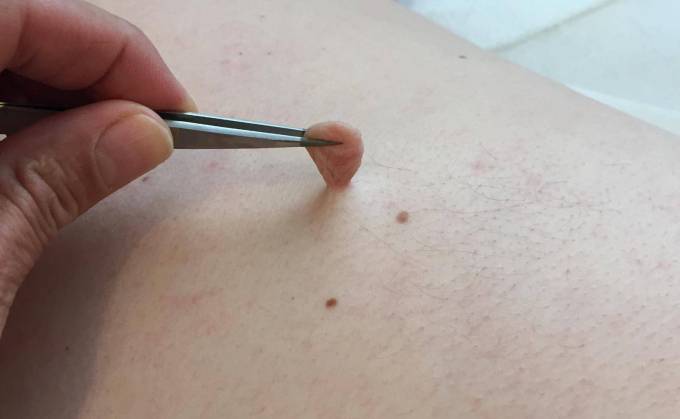How to Remove Skin Tags on Inner Thigh: Tips for Success
Published By Dynamic Clinic, 8 Oct 2024

Skin tags are benign, small growths that can occur anywhere on the body, including the inner thigh. While they are generally harmless, many individuals choose to remove them for aesthetic reasons or discomfort. This article provides effective tips for successfully How to Remove Skin Tags on Inner Thigh, ensuring a safe and effective process.
Understanding Skin Tags
What Are Skin Tags?
Skin tags, or acrochordons, are soft, skin-colored growths that hang off the skin. They can vary in size from a few millimeters to several centimeters. While skin tags are not painful, they may become irritated due to friction from clothing or skin rubbing together, especially in areas like the inner thigh.
Common Causes of Skin Tags
Although the exact cause of skin tags is not fully understood, several factors can contribute to their formation:
- Friction: Skin tags often develop in areas where skin rubs against skin or clothing.
- Hormonal Changes: Hormonal fluctuations during pregnancy or puberty may increase the likelihood of developing skin tags.
- Obesity: Extra weight can lead to more friction in skin folds, encouraging the formation of skin tags.
- Genetics: A family history of skin tags can increase your chances of developing them.
Tips for Successfully Removing Skin Tags
1. Consult a Healthcare Professional
Before attempting any removal technique, consult with a healthcare professional, such as a dermatologist. They can confirm that the growth is indeed a skin tag and recommend the best removal method for your situation. Professional guidance ensures that you avoid complications and prioritize your skin's health.
2. Choose the Right Removal Method
Selecting an appropriate method for removing skin tags is crucial for success. Here are some options to consider:
- Over-the-Counter Treatments: Many pharmacies offer OTC products specifically designed for skin tag removal. These products typically contain ingredients that help dissolve or dry out skin tags.
- Home Remedies: Natural remedies such as apple cider vinegar, tea tree oil, and garlic can be effective for some individuals. However, results can vary.
- Medical Procedures: If home remedies or OTC treatments are ineffective, professional options such as excision, cryotherapy, or electrosurgery may be necessary.
3. Follow Instructions Carefully
If using an OTC treatment or home remedy, always follow the instructions carefully. Adhering to the recommended application methods and duration is essential for achieving the desired results. Here’s how to effectively apply common home remedies:
Apple Cider Vinegar
- Soak a Cotton Ball: Saturate a cotton ball with apple cider vinegar.
- Apply to Skin Tag: Place the soaked cotton ball on the skin tag and secure it with a bandage.
- Leave it On: Allow it to sit for several hours or overnight.
- Repeat Daily: Continue this process for several days until the skin tag darkens and eventually falls off.
Tea Tree Oil
- Dilute the Oil: Mix a few drops of tea tree oil with a carrier oil (like coconut oil).
- Apply to Skin Tag: Use a cotton swab to apply the diluted mixture directly to the skin tag.
- Repeat Twice Daily: Apply this mixture twice daily until the skin tag falls off.
4. Keep the Area Clean
Before and after applying any treatment, ensure the area around the skin tag is clean. Gently wash the area with mild soap and water to remove any dirt or bacteria. After removal, continue to keep the area clean to prevent infection.
5. Be Patient
Skin tags may take time to fall off, especially when using home remedies. It’s essential to be patient and consistent with your chosen method. If using an OTC treatment, follow the recommended duration for best results.
6. Monitor for Signs of Infection
After removal, watch for signs of infection, such as redness, swelling, or discharge. If you notice any concerning symptoms, contact a healthcare professional immediately. Proper aftercare is vital for healing.
7. Avoid Irritation
After removing a skin tag, it’s important to minimize irritation to the area:
- Wear Loose Clothing: Choose breathable fabrics that reduce friction against the skin.
- Avoid Tight Underwear: Opt for underwear that doesn’t rub against the inner thigh, which can help the area heal more comfortably.
- Limit Physical Activity: If possible, avoid activities that may cause friction against the area until it has fully healed.
8. Stay Hydrated and Maintain Healthy Skin
Proper hydration and skincare can support overall skin health and may help prevent new skin tags from forming. Ensure you:
- Drink Plenty of Water: Staying hydrated is essential for skin health.
- Moisturize Regularly: Use a gentle moisturizer on the inner thigh area to keep the skin hydrated and healthy.
- Maintain a Healthy Diet: Eating a balanced diet rich in vitamins and minerals supports skin health.
Conclusion
Removing skin tags from the inner thigh can be achieved successfully through various methods, including home remedies, over-the-counter treatments, and professional procedures. Consulting a healthcare professional before attempting removal is essential to ensure safety and effectiveness. By following these tips for success, you can effectively manage skin tags while prioritizing your skin health. Remember to be patient, monitor for signs of infection, and maintain a healthy lifestyle to support your skin's well-being.
